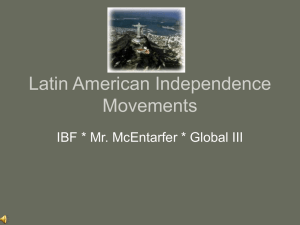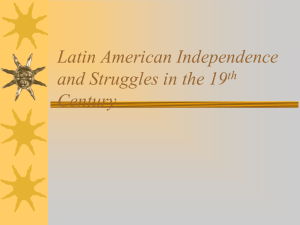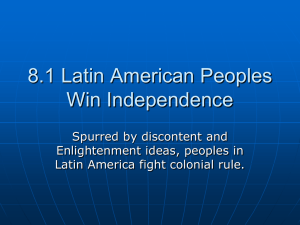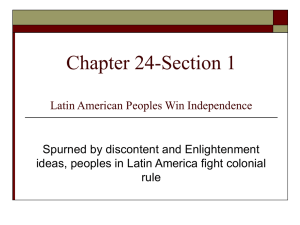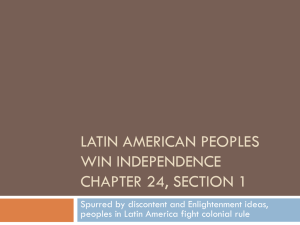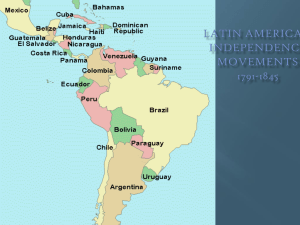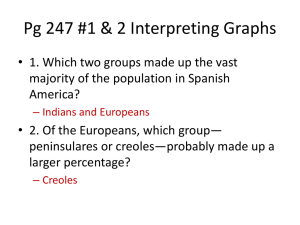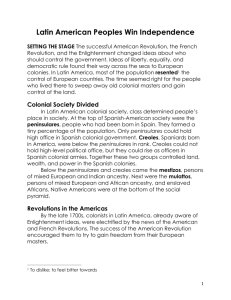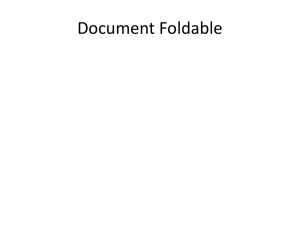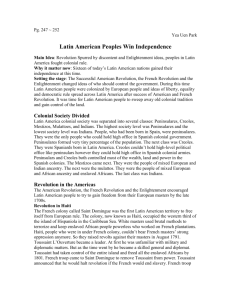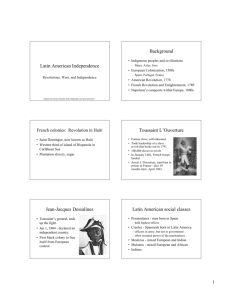Latin American Peoples Win Independence
advertisement
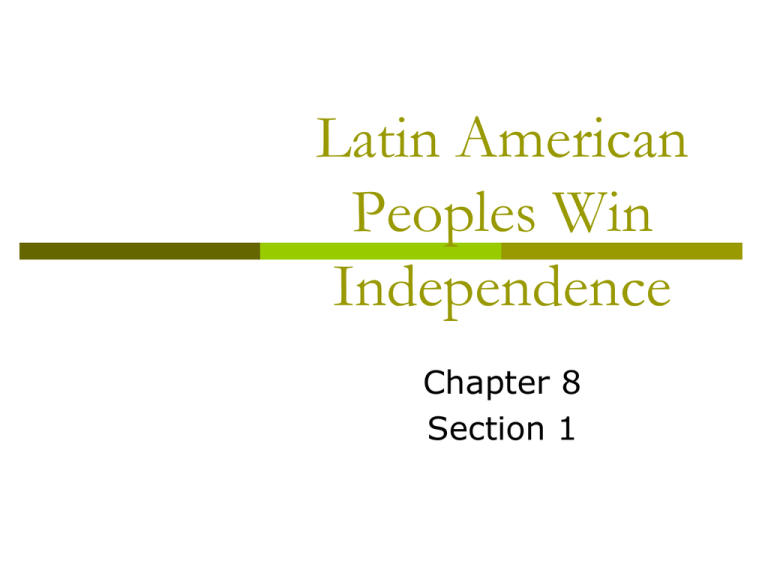
Latin American Peoples Win Independence Chapter 8 Section 1 Main Idea Spurred by discontent and Enlightenment ideas, peoples in Latin America fought colonial rule. Sixteen of today’s Latin American nations gained their independence at this time. Present Day Latin America Introduction Ideas changed about who should control the government due to the American Revolution, French Revolution and the Enlightenment. Ideas of liberty, equality and democratic rule made their way to the European colonies. Latin American colonies resented European colonial powers. Colonists decided to gain control of their land. Colonial Society Divided Class dictated peoples place in society and their jobs. How does this compare to our society today? Latin American colonies were divided into five main groups: Peninsulares Creoles Mestizos Mulattos Indians Peninsulares Born in Spain Small percentage of population Only group that could hold a high governmental office Creoles Spaniards born in Latin America Ranked below peninsulares Could not hold a high political office Could rise as officers in the army Mestizos Ranked below peninsulares and creoles Mixed European and Indian ancestry Mulattos Mixed European and African ancestry Indians Bottom of social ladder Revolutions in the Americas News of the American and French Revolution had spread to the colonies. The success of the American Revolution encouraged them to try to gain freedom from the European masters. Revolution in Haiti Saint Domingue – First European colony to free itself from European rule. N/K/A – Haiti French colony 500,000 African slaves worked on French plantations Greatly outnumbered their masters Brutal methods were used to keep the slaves powerless. During the French Revolution The oppressed people of Haiti rose up against their French masters. August 1791 – 100,000 enslaved Africans rose in revolt. Leader – Toussaint L’Ouverture Took control of the entire island and freed all the enslaved Africans January 1792 – 30,000 French came to Saint Domingue to remove Toussaint from power. Haitian Revolution Toussaint L’Ouverture Toussaint agreed to stop the revolution IF the French would end slavery. The French agreed. However, the French sent him away to die in prison. Haiti’s Independence Toussaint’s lieutenant – Jean-Jacques Dessalines Continued to fight for freedom. January 1, 1804 – Dessalines declared Haiti an independent country. First black colony to free itself from European rule. Questions 1. 2. 3. 4. 5. What are Peninsulares? What are Creoles? How many classes of people were there in Latin American colonial society? Who emerged as the leader of enslaved Africans in the Saint Domingue revolt? What does the word Haiti mean? Creoles Lead Independence Creoles were the least oppressed of those born in Latin America. Well-educated Traveled to Europe to be educated. Brought back ideas of the revolution with them. Napoleon and Spain Napoleon removed Spain’s king and made his brother king. Creoles considered the new king as French and did not support his rule. Creoles justified their actions with Locke’s idea of consent of the governed. Since king was removed, power shifted to the people. Rebellion broke out. Simon Bolivar Creole general, from Venezuela Venezuela declared its independence from Spain in 1811. Spain wouldn’t accept the declaration. Bolivar led an victorious army and by 1821, Venezuela was independent. Jose de San Martin Creole general, from Argentina Declared Argentina’s independence in 1816. San Martin freed Chile. Devised a plan with Bolivar to free Peru. Bolivar leads San Martin’s Army Pursuant to their agreement, San Martin left his army for Bolivar to lead. Defeated the Spanish in 1824. This was the last battle in the war for independence. The Spanish colonies won their freedom. The future countries of Venezuela, Colombia, Panama and Ecuador became known as the Gran Colombia. Mexico Ends Spanish Rule In most Latin America countries, creoles led the revolutionary movements. In Mexico, however, ethnic and racial groups mixed more freely. Indians and mestizos played the leading role in revolutionary movements. A Cry for Freedom 1810 – Padre Miguel Hidalgo took the first step toward independence. Hidalgo firmly believed in Enlightenment ideas. Rang his church bells to gather a crowd on September 16, 1810. When the peasants gathered, he called for a rebellion against the Spanish. March toward Mexico City The next day, 80,000 Indian and mestizo followers marched toward Mexico City. This uprising of the lower classes alarmed the Spanish army and creoles. Feared loss of land, control and their lives. Army defeated Hidalgo in 1811. Mexico’s Independence 1820 – Spain put a liberal group in power in Mexico. Creoles feared loss of their privileges. They united in support of Mexico’s independence. Mexico proclaimed independence in 1821. Central America Central America had been governed by Spain. 1821 – several Central American states declared their independence from Spain. The emperor of Mexico refused to recognize the declaration. 1823 – emperor was overthrown. Became known as Provinces of Central America: Nicaragua, Guatemala, Honduras, El Salvador and Costa Rica. Brazil’s Royal Liberator Brazil’s request for independence was unusual. It did not involve violence. 1807 – Napoleon’s armies invaded both Spain and Portugal to close the ports to British shipping. The royal family boarded ships to Brazil to escape capture. Made Rio de Janeiro the capital of Brazil. Brazil’s Independence Portugal was governed from Brazil for 14 years. After Napoleon’s defeat in 1815, the royal family returned to Portugal six years later. The king’s son, Dom Pedro, stayed behind in Brazil. It was the king’s intent to return Brazil to a colony status. Bloodless Revolution 1822- 8,000 Brazilians signed a petition asking for its independence. They asked Dom Pedro to rule. The King agreed to Brazil’s independence. Questions 1. 2. 3. 4. Name the group that led to the nationalist movement in Latin America. Why were people inspired to follow Padre Miguel Hidalgo in his rebellion? What is the rebellion on September 16, 1810 known as? Describe the difference in the liberations of Brazil and Mexico.
